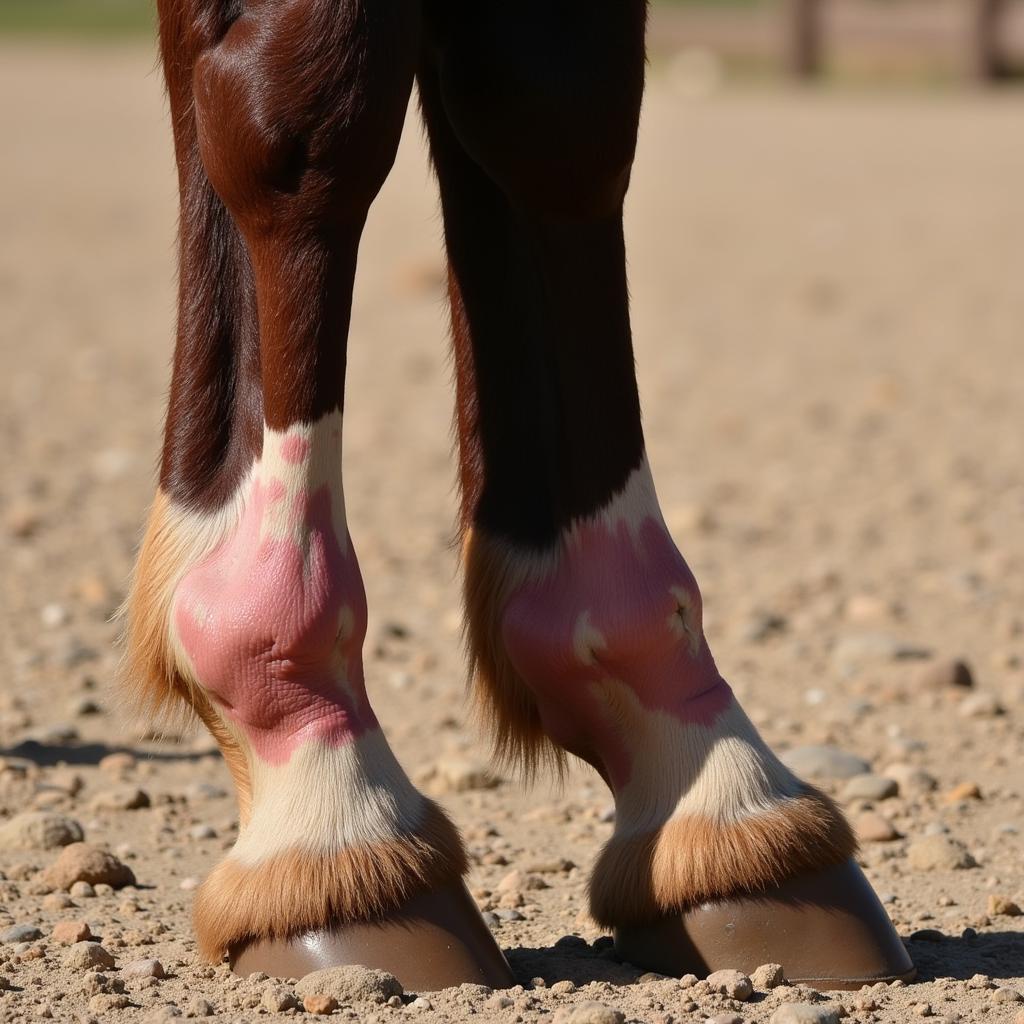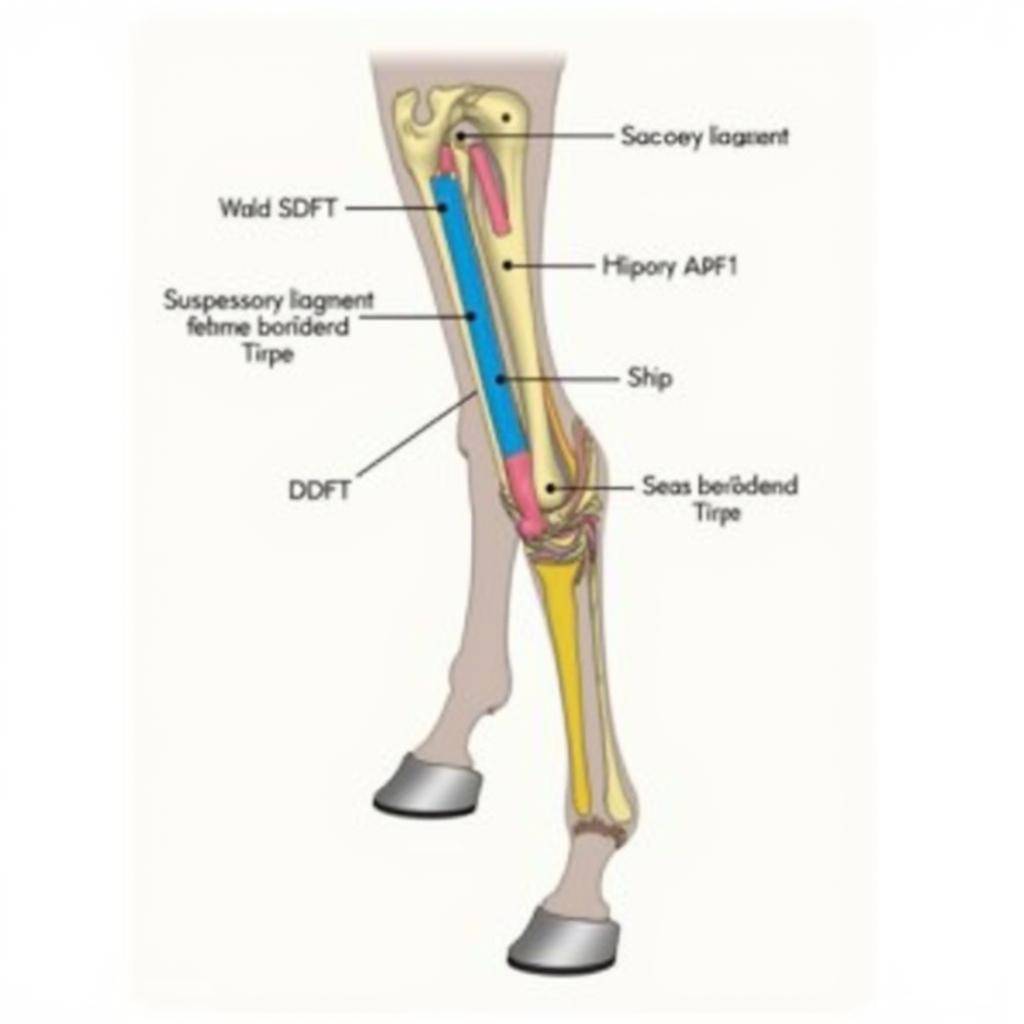Hind leg horse tendon injuries are a significant concern for horse owners, often causing lameness and requiring extensive rehabilitation. Understanding the different types of tendon injuries, recognizing the signs, and knowing how to seek appropriate veterinary care are crucial for a horse’s well-being. This article will delve into the complexities of hind leg horse tendon injuries, providing valuable insights, practical advice, and visual aids to help you navigate this challenging situation.
Recognizing Hind Leg Tendon Injuries in Horses
Identifying a hind leg tendon injury early is crucial for successful treatment. Symptoms can range from subtle to severe, including lameness, swelling, heat, and pain on palpation. The severity of the lameness often correlates with the extent of the injury. Sometimes, the injury might be so minor that you only notice a slight change in the horse’s gait or performance. Other times, the horse might exhibit obvious lameness and be unwilling to bear weight on the affected leg. It’s crucial to pay close attention to any changes in your horse’s movement and behavior.
Horses are athletes, and just like human athletes, they can suffer from strains, sprains, and tears in their tendons. The hind legs, responsible for powerful propulsion, are particularly susceptible to these types of injuries. Recognizing the subtle signs, such as a slight head bob when the affected leg hits the ground or a reluctance to perform certain movements, can make all the difference in the long run. Early intervention and proper veterinary care are essential for the best possible outcome.
 Swollen Hind Leg Tendon in a Horse
Swollen Hind Leg Tendon in a Horse
Common Types of Hind Leg Tendon Injuries in Horses
Several tendons in the horse’s hind leg are prone to injury. The most commonly affected are the superficial digital flexor tendon (SDFT), the deep digital flexor tendon (DDFT), and the suspensory ligament. The SDFT runs along the back of the leg and helps flex the fetlock and pastern joints. The DDFT lies deeper and flexes the coffin joint. The suspensory ligament supports the fetlock and prevents it from overextending. Injuries to these structures can occur due to various factors, including trauma, overuse, poor conformation, and inadequate conditioning.
Understanding the anatomy of the equine hind leg can be invaluable when dealing with tendon injuries. Knowing the location and function of each tendon helps you understand the nature of the injury and its potential impact on the horse’s movement. For example, an injury to the SDFT might result in a dropped fetlock, while a suspensory ligament injury can cause the fetlock to sink closer to the ground. This knowledge allows you to communicate more effectively with your veterinarian and participate more fully in your horse’s recovery process.
 Equine Hind Leg Tendon Anatomy Diagram
Equine Hind Leg Tendon Anatomy Diagram
Diagnosis and Treatment of Hind Leg Horse Tendon Injuries
Diagnosing a hind leg tendon injury typically involves a physical examination, lameness evaluation, and diagnostic imaging such as ultrasound. Ultrasound is particularly useful for visualizing the extent of the damage to the tendon fibers. Treatment options vary depending on the severity and location of the injury. Conservative management may include rest, cold therapy, bandaging, and controlled exercise. More severe injuries may require surgical intervention.
The rehabilitation process for hind leg tendon injuries can be lengthy and requires patience and dedication. It often involves a gradual return to exercise, starting with walking and slowly progressing to more strenuous activities. Regular veterinary check-ups and ultrasound monitoring are essential to assess the healing progress and adjust the rehabilitation plan as needed. The ultimate goal is to restore the horse’s soundness and prevent re-injury.
 Ultrasound Image of a Hind Leg Tendon Injury
Ultrasound Image of a Hind Leg Tendon Injury
Conclusion: Caring for Your Horse with a Hind Leg Tendon Injury
Hind leg horse tendon injuries can be challenging to manage, but with prompt diagnosis, appropriate treatment, and diligent rehabilitation, many horses can return to soundness. Understanding the signs, types, and treatment options for these injuries empowers horse owners to make informed decisions and provide the best possible care for their equine partners.
FAQ
-
What are the first signs of a hind leg tendon injury in a horse?
Lameness, swelling, heat, and pain in the affected area are common signs. -
How are hind leg horse tendon injuries diagnosed?
Diagnosis typically involves a physical exam, lameness evaluation, and often ultrasound imaging. -
What is the treatment for a hind leg tendon injury?
Treatment ranges from conservative management (rest, ice, bandaging) to surgical intervention depending on the severity. -
How long does it take for a hind leg tendon injury to heal?
Healing time varies but can take several months to a year, depending on the severity and the horse’s individual response to treatment. -
Can a horse fully recover from a hind leg tendon injury?
Many horses can make a full recovery, especially with early diagnosis and proper management. -
What can I do to prevent hind leg tendon injuries in my horse?
Proper conditioning, balanced nutrition, and avoiding overexertion can help prevent injuries. -
Where can I find more information about hind leg horse tendon injuries?
Consult with your veterinarian and reputable equine resources.
Need more help? Contact us at Phone: 0772127271, Email: [email protected] or visit our address at QGM2+WX2, Vị Trung, Vị Thuỷ, Hậu Giang, Vietnam. We have a 24/7 customer service team.